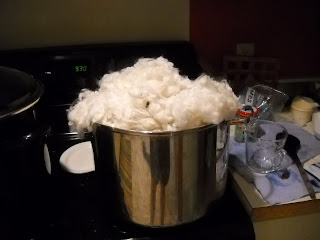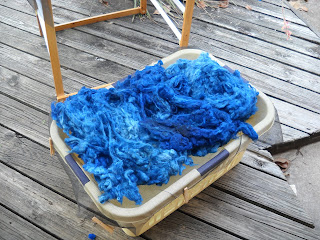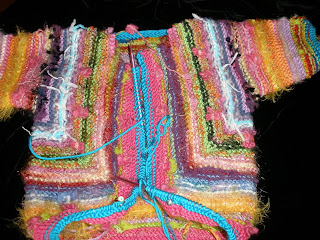
Mitered Square Cap
From Topflappen Hat by Charlene Schurch, in Hats On!! 31 Warm and Winsome Caps for Knitters, published by Down East Books, 1999. Schurch gives credit to Horst Schultz, Das Neue Stricken Kindermode.
Size: Adult large, circumference 19.5”.
Gauge: each square measured on the diagonal: 3.25”.
Needles: U.S. size 6 or 7, check gauge to be sure.
By Jennifer Thompson Miller, M.A.
One Color Half Squares (downward pointing triangles):
Row 1. Using knit cast-on, c/o 23 st.
Row 2. RS – s1, k2 tog tbl, k7, s1 k2tog psso, k9, p1. 20 st.
Row 3. WS - s1, k2 tog tbl, k to last stitch, p1. 19 st.
Row 4. s1, k2 tog tbl, k5, s1 k2tog psso, k7, p1. 16 st.
Row 5. s1, p2tog, p to end. 15 st.
Row 6. s1, k2 tog tbl, k3, k to last stitch, p1. 12 st.
Row 7. s1, k2 tog tbl, k to last stitch, p1. 11 st.
Row 8. s1, k2 tog tbl, k1, s1 k2tog psso, k3, p1. 8 st.
Row 9. s1, p2tog, p to end. 7 st.
Row 10. s1, k1, s1 k2tog psso, k2 tog, p1 – 5 st.
Row 11. Bind off.
Two Color Half Square (downward pointing triangles):
Row 1. MC. Using knit cast-on, c/o 23 st.
Row 2 (RS). k1, k2 tog tbl, k7, s1 k2tog psso, k9, p1
Row 3 (WS). s1, k2 tog tbl, k to last stitch, p1
Row 4. CC - s1, k2 tog tbl, k5, s1 k2tog psso, k7, p1
Row 5. s1, p2tog, p to end. – 15 st
Row 6. MC - s1, k2 tog tbl, s1 k2tog psso, k to last stitch, p1
Row 7. s1, k2 tog tbl, k to last stitch, p1
Row 8. CC - s1, k2 tog tbl, k1, s1 k2tog psso, k3, p1
Row 9. s1, p2tog, p to end. 7 st.
Row 10. MC - s1, k1, s1 k2tog psso, k1, p1 – 5 st.
Row 11. Bind off.
Two Color Full Square –
Picking up stitches from existing squares
Row 1. MC. Pick up 23 stitches: 11 from the right-hand square, 11 from the left-hand square, 1 from each triangle where they join.
Row 2 (RS). K10, s1 k2tog psso, k9, p1
Row 3 (WS). s1, k to last stitch, p1
Row 4. CC. s1, k8, s1 k2tog psso, k8, p1
Row 5. s1, p to end
Row 6. MC s1, k7, s1 k2tog psso, k7, p1
Row 7. s1, k to last stitch, p1
Continue working these two colors until 3 stitches remain.
Last WS row: s1, k1, p1
Last RS row: s1 k2tog psso, do not bind off last stitch – use this stitch for next square.
Abbreviations
Sl1– slip one stitch as if to purl with yarn in back
k2 tog tbl – knit 2 together through the black loop
s1 k2tog psso – slip one, knit 2 together, pass slipped stitch over the knit stitch
p3tog – purl 3 together
MC – Main Color
CC – Contrast Color.
RS - Right Side
WS – Wrong Side
Construction of Cap
Begin by making 6 half squares. Place 2 half-squares with their points up. Pick up and knit 11 st from each half-square and 1 st from the places where these two half-squares join. Work a full square. Repeat this process until you get to square #6, which will close the circle of the squares.
Continue working 2 more rows of squares as shown in the diagram. After you have completed square 18, work 6 more half-squares around the top of the cap.
Cuff
Round 1: Using MC and dp needles (or a 16"
circular needle), pick up and knit 78 stitches
along the edge of the half squares that you
have just finished (13 st across the long side of
each half square).
Round 2: purl
Round 3 and 4: K, using CC
Round 5: k MC
Round 6: p MC
Rounds 7 and 8: K, using CC
Round 9: k MC
Round 10: p MC
Bind off in MC.
Top of cap
Round 1: Using MC and dp needles (or a 16"
circular needle),beginning at the center of one
of the half squares, pick up and knit 90 stitches
(15 st across the long side of each half square).
Switch to dp needles as stitches decrease.
Round 2: MC. *p6, p3tog, p6*, repeat around.
Round 3: CC. Knit.
Round 4: CC. *k5, s l k2tog psso, k5*, repeat
around.
Round 5: MC. Knit.
Round 6: MC. *p4, p3tog, p4*, repeat around.
Round 7. CC. Knit.
Round 8. CC. *k3, s l k2tog psso, k3*, repeat
around.
Round 9. MC. Knit.
Round 10. MC. *p2, p3tog, p2*, repeat around.
Round 11. CC. Knit.
Round 12. CC. *kl, s l k2tog psso, kl*, repeat
around.
Round 13. MC. Knit.
Round 14. MC. *sl k2tog psso*, repeat around.
Break off yarn with an 8" tail and thread the
end into a yarn needle. Draw the thread
through remaining stitches and fasten off.

I am not sure why the chart is not showing up clearly. Stay tuned, I am working on it. Meanwhile, double click on the chart & it will appear big enough to print/follow.
Please post any comments or feedback! I appreciate all of you!
Jennifer@dizzylettuce.com
Dizzylettuce on Ravelry




















